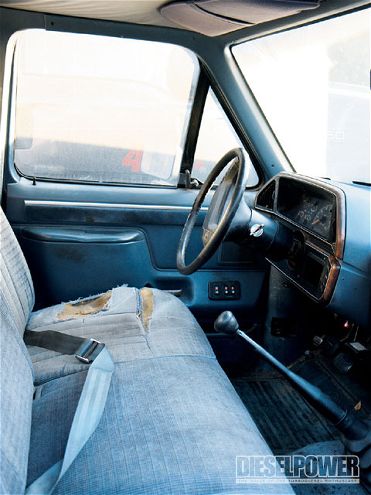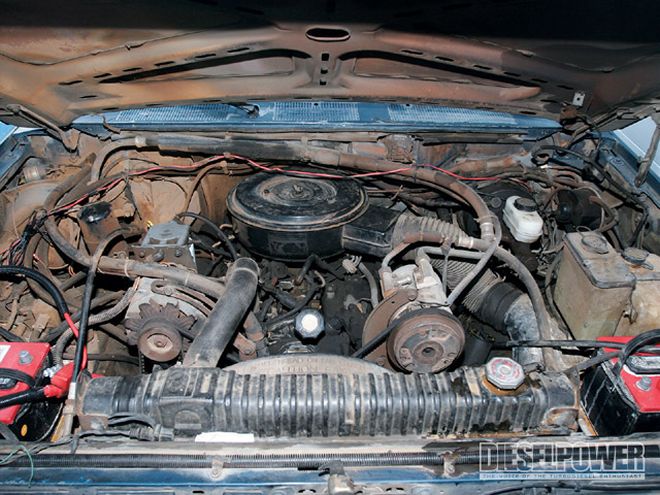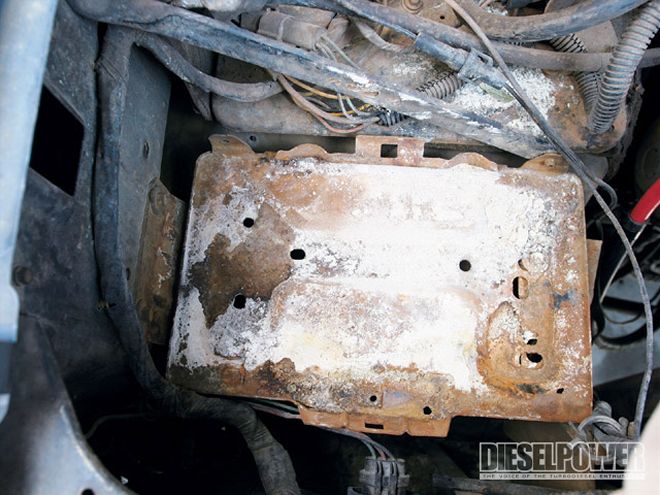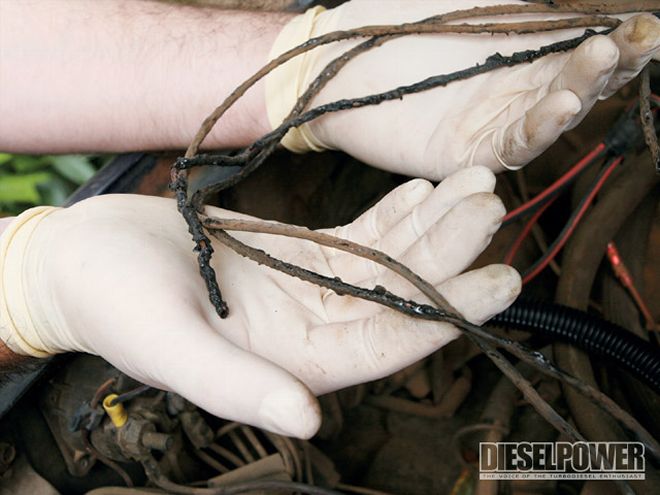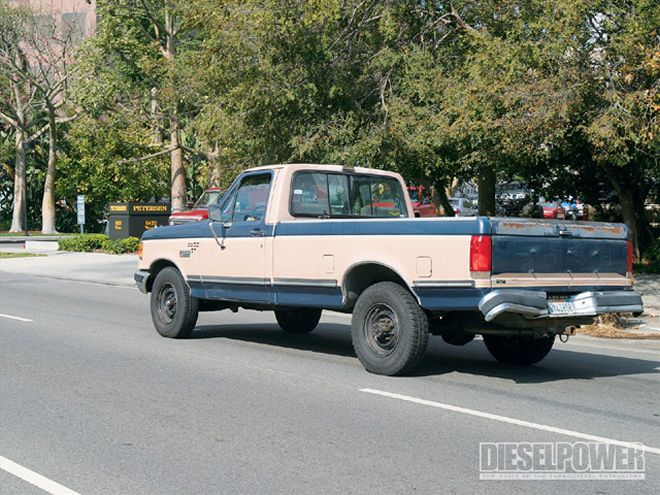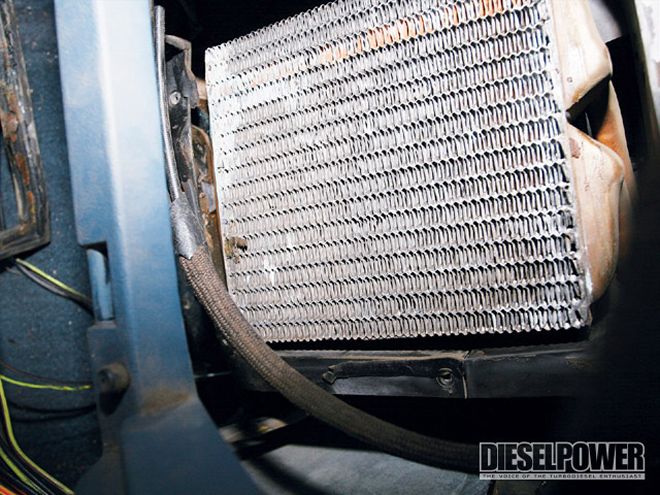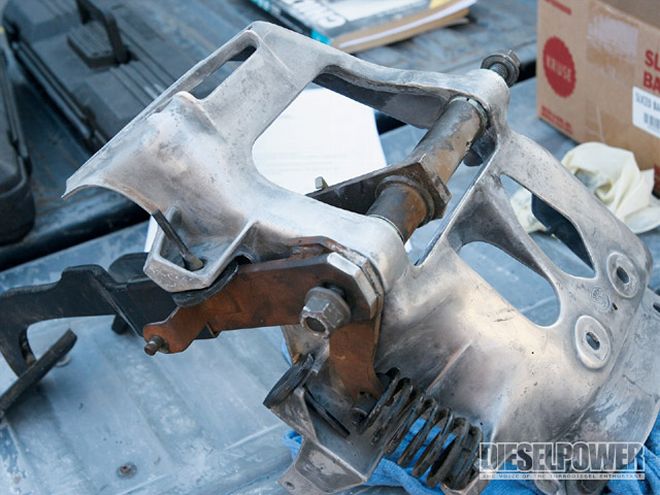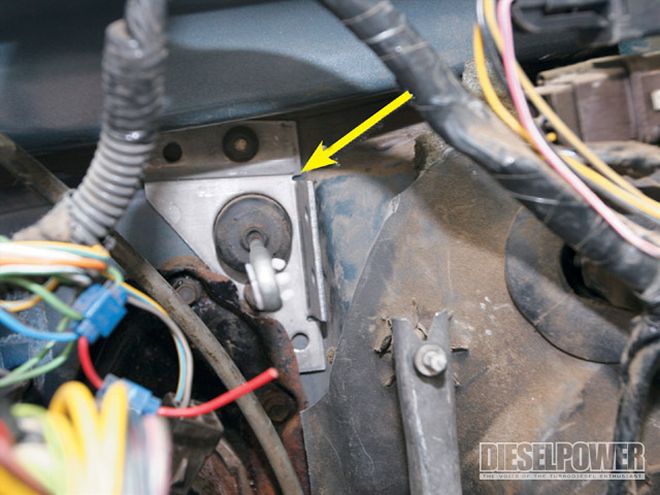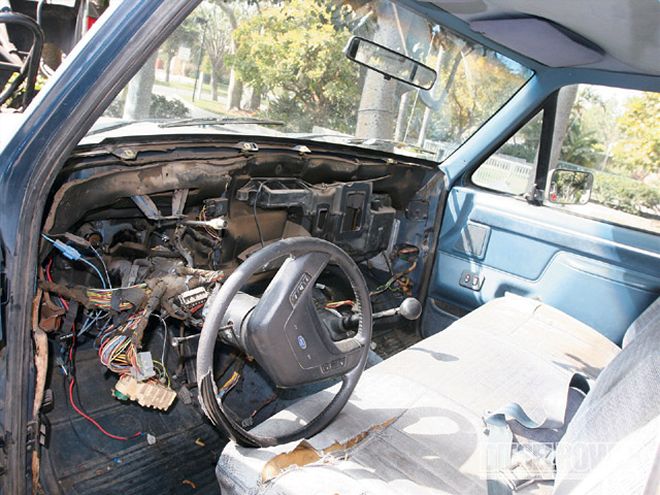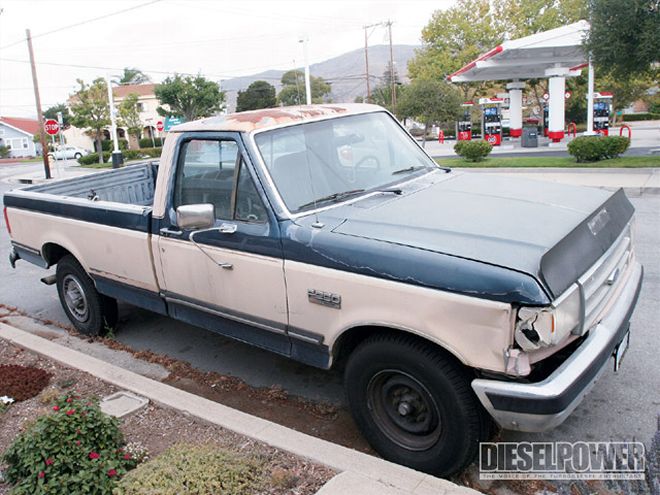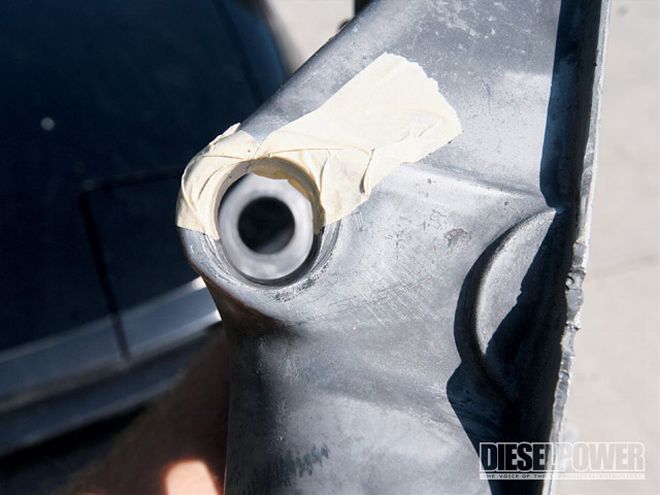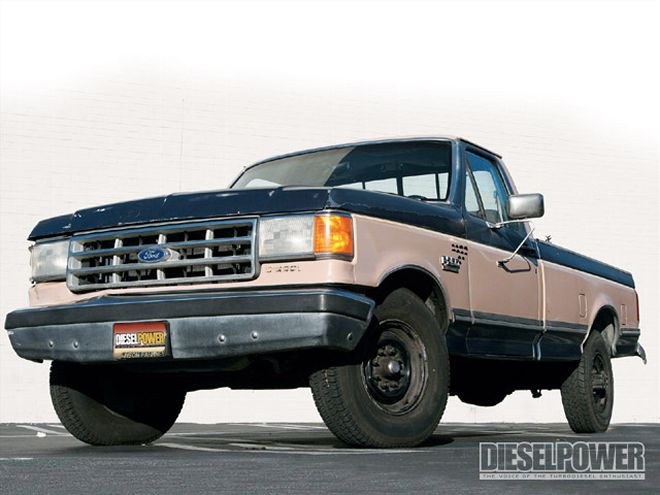
| 1987 Ford F250 left Front Angle
This whole story began with a simple email from our Associate Publisher, David Hamilton, who had a friend with a cheap diesel truck for sale. The line in David's email that grabbed our attention was: "My friend is selling (giving away) his '87 Ford F-250 diesel, single cab, longbed for a couple hundred bucks. It's been sitting a while, so it just needs a little tune-up." It was the "giving away" part we couldn't resist. We called David's friend to ask if the 6.9L engine still ran-he answered that "it did when I parked it over two years ago." That sounded good enough to us, and we told him we'd be there to pick it up in a few days.
Rescue MissionWith tools packed, jumper cables ready, and the phone number of a tow truck company in hand, we set off on our mission to get the diesel home one way or another. During the 200-mile trip to get the truck, the anticipation of seeing the future project vehicle was intense. When we finally saw the two-tone F-250 rotting away on the side of the road-it was truly love at first sight. The sheetmetal was rust-free, the tires had air, and there weren't any big puddles of oil or water staining the ground beneath it. The fact that the truck had been ordered with a regular cab and a manual transmission created an interesting juxtaposition next to its premium XLT Lariat package. It was basically an old farm truck with cruise control, A/C, and power windows and door locks.
What We Got For $300We found the 6.9L International was connected to a ZF S5-42 five-speed manual with an aluminum main case and integral bellhousing. The S in the ZF S5-42 model name is short for synchronized, the 5 designates the number of speeds (not counting reverse), and the 42 stands for the ZF's torque capacity of 420 lb-ft. An external slave cylinder was used on early '87 ZF models. Since it is on the outside of the bellhousing, it can be replaced without removing the transmission. The rear axle is a Ford 10 1/4-inch with 35-spline 1 1/2-inch axles and full-floating wheel hubs. That means the drive axles do not support the vehicle's weight; their sole function is to transmit power to the drive wheels. Each axleshaft rides in two roller bearings within the axlehousing, and the housing in turn supports the wheels and vehicle weight. The gross axle weight rating (GAWR) for the frontend is 3,540 pounds while the rear is 6,084 pounds. The F-250's gross vehicle weight rating (GVWR) is 8,600 pounds. To slow all this weight down, the frontend relies on 12 1/2 -inch rotors with dual-piston calipers. The rear brakes are 12-inch-diameter drums.
Tow It, Or Drive It?In hindsight, we should have offered $250 instead of $300 since it was an F-250. Either way, the deal was done and now we needed to get the truck 200 miles south. The first question we asked ourselves was: will it roll? In our case we had what looked like four brand-new tires. They were a little low on air and covered with cobwebs. No problem. The first question begs the next: should it roll? After popping the hood, and finding a proper stick to make it stay open, it was discovered that the brake master cylinder was empty. Upon further inspection, the engine's oil level was somewhere out of reach of the dipstick. Those two strikes made the decision of calling the tow truck easy.
Once home, the engine and transmission were drained and filled with 10 quarts of 15w40 and nearly 4 quarts of fully synthetic automatic transmission fluid (ATF) respectively. A 3/8-inch extension fits both the drain and fill plugs on the ZF. The brakes were bled in order to remove air bubbles, the multiple V-drive belts were adjusted to adequate tension, and the fuel filter was changed. We considered draining the fuel and putting in fresher stuff, but figured the simple Stanadyne DB2 rotary injection pump could handle it. We put in two Yellow Top Optima batteries, flipped the switch for the auxiliary electric fuel pump, and pushed the little red button wired to the starter solenoid. After a few cranks with nothing significant happening, we added a little ether. That's all it needed, and the F-250 was running. Each Optima battery comes rated at 750 cold cranking amps (CCA). We will need all of that power since our engine has a compression ratio of 21.5:1. With the engine running, the only thing left to do was a test drive. This was not to be, since we could not get the transmission to shift into First, Second, or Reverse.
The Transmission That Wouldn't Shift And The Fuel Pump That Came ApartOur shifting problem was due to the external slave cylinder not getting its full 7/16-inch of travel. There were three possible causes of this problem. First, the hydraulic clutch system could have air in it, second, the firewall could be damaged and flex where it shouldn't, or three, the pedal assembly itself could be worn and in need of repair. Our truck was in need of a pedal assembly rebuild. If the problem was detected early, new plastic bushings could've solved the wear issue. In our case the magnesium pedal bracket had worn so badly it needed JB Weld to replace the magnesium that has worn away. We decided to order Ford part number E3TZ-7K509-A as a preventative measure against firewall fatiguing. It is basically a reinforcement kit so your hydraulic clutch master cylinder nuts don't get pushed through the firewall.
The mechanical fuel pump mounted on the side of the engine then disintegrated and was replaced with a new one. This final repair made the cheap diesel a strong runner.
DP
Should You Buy a $300 Diesel?Here are a few good candidates for a $300 diesel project:*A 16-year-old looking for a first car
*A worker hunting for cheap, useful transportation
*A farmer/rancher looking to replace the last truck they drove into the ground
*A racer looking to build a race truck
As a rule of thumb, if you purchase a vehicle for the price it takes to fill the tank twice, you are going to have some work ahead of you. The amount of toil depends on an infinite number of variables, but there are a few scenarios that can make cheap diesels really good deals. The first thing you have to do is ask yourself: why is the owner selling this?
Reasons favorable to the buyer include: financial trouble for the owner, the party is moving cross country, or the wife just wants it off the property. Another situation is the vehicle has something wrong with it which took it out of operation. The problem could be giant and catastrophic, or simple and small. If you can repair the weak link, making the vehicle operational again-you just might have found the key to a cheap diesel.
PRICE LIST '87 {{{F-250}}} 140,000-mile two-wheel drive ${{{300}}} DMV registration (needed to get towed) $115 {{{200}}}-mile tow home AAA membership {{{Optima}}} Yellow Top batteries $300 Motor oil 15W-40 10 quarts $20 Synthetic ATF 4 quarts $10 Oil filter $11 Fuel filter $16 Air filter $11 JB Weld $6 Firewall reinforcement $17 Fuel pump $32 Alternator belt $11 Large drip pan $10 Two plastic buckets with lids
(for bed storage) $15 Spray paint (Rosewood Satin) $4 Paint and rust stripper disc $10
Total: $788
 | 1987 Ford F250 left Front Angle
This whole story began with a simple email from our Associate Publisher, David Hamilton, who had a friend with a cheap diesel truck for sale. The line in David's email that grabbed our attention was: "My friend is selling (giving away) his '87 Ford F-250 diesel, single cab, longbed for a couple hundred bucks. It's been sitting a while, so it just needs a little tune-up." It was the "giving away" part we couldn't resist. We called David's friend to ask if the 6.9L engine still ran-he answered that "it did when I parked it over two years ago." That sounded good enough to us, and we told him we'd be there to pick it up in a few days.
Rescue Mission
| 1987 Ford F250 left Front Angle
This whole story began with a simple email from our Associate Publisher, David Hamilton, who had a friend with a cheap diesel truck for sale. The line in David's email that grabbed our attention was: "My friend is selling (giving away) his '87 Ford F-250 diesel, single cab, longbed for a couple hundred bucks. It's been sitting a while, so it just needs a little tune-up." It was the "giving away" part we couldn't resist. We called David's friend to ask if the 6.9L engine still ran-he answered that "it did when I parked it over two years ago." That sounded good enough to us, and we told him we'd be there to pick it up in a few days.
Rescue Mission